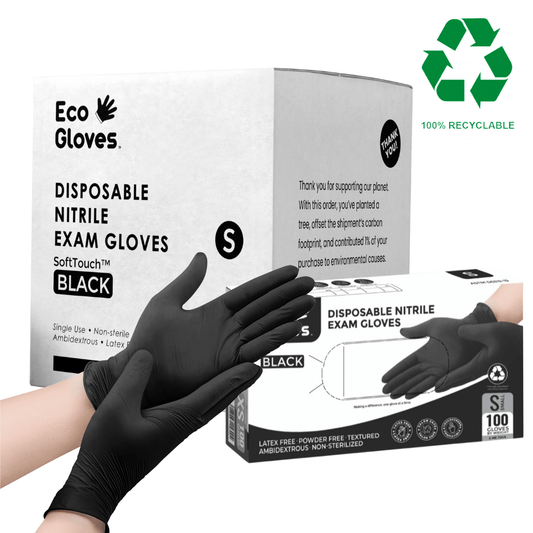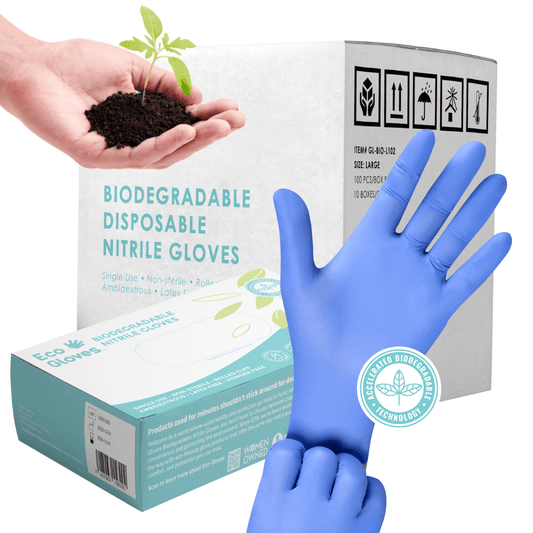Top 5 Affordable Disposable Gloves That Don’t Compromise Quality
Eco Gloves
Balancing Cost and Quality in Disposable Gloves
Affordability shouldn’t mean sacrificing protection or performance. Whether you run a restaurant, salon, or cleaning business, the best disposable gloves combine price, durability, and compliance for the task at hand.
In this guide, we’ll compare the most common low-cost glove types—nitrile, vinyl, TPE, and PE—to help you choose the right fit for your budget and safety needs. You’ll also find practical cost-saving strategies for buying in bulk or wholesale.
Topics Covered
- Price vs. Performance: How to Think About “Value Gloves”
- The Top 5 Affordable Disposable Glove Picks (By Use Case)
- When and Where Budget Gloves Are the Right Choice
- Quick Glove Material and Price Comparison Table
- Evidence Snapshot: Why Nitrile Gloves Often Win on “Value”
- How to Buy Gloves: A Quick Checklist
- Budget Without Risk: Practical Cost-Saving Tips When Buying Gloves
- Key Takeaways
- Conclusion
- Frequently Asked Questions (FAQs)
Price vs. Performance: How to Think About “Value Gloves”
The “cheapest” glove doesn’t always yield the lowest cost per task. A glove that tears easily, loses shape during use, or offers weak barrier protection can lead to higher replacement rates, contamination risks, and wasted product. In the long run, low-quality gloves cost more — both financially and environmentally.
OSHA guidelines require employers to select hand protection based on the specific hazards, chemical exposure, and task demands, reinforcing that “fit for purpose” is the first screening criterion before price.
Independent studies consistently show meaningful differences in barrier integrity between glove polymers, especially once gloves are manipulated during real-world use. Research comparing materials under simulated in-use conditions found vinyl failure rates jumping from 12% up to 61%, while nitrile gloves and latex remained in the low single digits (≈1–4%). That gap matters if you handle ready-to-eat foods, bodily fluids, solvents, or abrasive tasks.
Glove thickness also affects performance. Peer-reviewed work measuring 4–5 mil nitrile demonstrates a practical balance of dexterity and durability; as thickness increases, puncture and some chemical resistance generally improve, albeit with slightly less tactile feel.
Ultimately, “value gloves” are those that balance quality, performance, and price for the specific task. Investing in durable, well-fitting nitrile gloves — especially when purchased in bulk or wholesale quantities — can reduce waste, lower replacement frequency, and minimize environmental impact. Choosing smarter gloves doesn’t just protect your hands; it protects your bottom line and the planet, too.
The Top 5 Affordable Disposable Glove Picks (By Use Case)
Below are five value-forward categories that cover most day-to-day tasks, each selected to reduce cost without compromising essential performance.
1. Budget 3–4 Mil Nitrile Gloves — The Everyday MVP
Best for: food prep/food service, janitorial, beauty/salon services, pet care, hobby/crafting, travel kits.
Why they’re affordable: 3–4 mil nitrile gloves offer strong barrier protection and excellent dexterity, making them the best “value” glove for frequent use. They’re latex-free, puncture-resistant, and widely available in bulk cases and wholesale exam glove packs, which lower per-glove cost significantly.
When to upgrade: Choose thicker 5–6 mil nitrile for heavy-duty or chemical-handling tasks.
💡 Pro Tip: Buying nitrile gloves by the case can save up to 20–30% compared to single-box purchases.
2. Thicker 5–6 Mil Nitrile Gloves — For Tougher Jobs
Best for: automotive detailing, facilities maintenance, light industrial tasks, more abrasive janitorial work, facilities handling chemicals per SDS guidance.
Why they’re affordable: Though the unit price is slightly higher, thicker nitrile gloves last longer and reduce change-outs—cutting your real “cost per hour.” For businesses that go through gloves quickly, this translates to measurable savings and better worker protection.
3. Vinyl Gloves — Low-Cost Option for Light Tasks
Best for: Quick food handling, general cleaning, customer service, or short tasks with minimal risk.
Why they’re affordable: Vinyl is among the cheapest disposable glove materials available. However, they tend to tear more easily and offer lower chemical resistance than nitrile.
4. TPE Gloves — A Smart Midpoint Between Vinyl and Nitrile
Best for: Foodservice, cleaning, and general-purpose applications needing comfort and flexibility.
Why they’re affordable: TPE (Thermoplastic Elastomer) gloves are cost-effective and provide better elasticity and fit than vinyl while remaining latex-free. TPE gloves often come in high-count packs (200–300 gloves per box), further reducing cost per glove. They’re also less likely to break under tension and are approved for food contact, making them ideal for restaurants and kitchens seeking an upgrade from vinyl without nitrile pricing.
5. PE Gloves — The Ultra-Budget Choice
Best for: Food sampling, grocery handling, quick cleaning, or short one-time-use tasks.
Why they’re affordable: Polyethylene (PE) gloves are extremely lightweight and inexpensive, ideal for high-turnover tasks where frequent glove changes are required. They’re not suitable for heavy-duty or chemical exposure but excel where volume and speed matter.
⚠️ Note: Use PE gloves only for short, non-hazardous tasks—durability is limited.

When and Where Budget Gloves Are the Right Choice
While premium gloves are essential for high-risk or chemical-intensive work, there are many industries and tasks where economical or mid-range disposable gloves provide reliable protection without unnecessary cost. Here’s where value-based options perform well — and when to upgrade.
Food Service & Hospitality
The FDA Food Code (2022) emphasizes preventing bare-hand contact with ready-to-eat foods and maintaining hand hygiene. 3–4 mil nitrile gloves usually strike the right balance of price and performance for most food-prep stations. Vinyl or PE gloves may be used for quick, low-risk tasks like sandwich assembly or serving prepackaged foods, but many operators standardize on nitrile to reduce breakage and maintain consistency.
Education & Daycare
Frequent glove changes for snack distribution, arts and crafts, or light cleanup call for economical, latex-free options. Schools often choose budget nitrile gloves for versatility and safety, avoiding allergy concerns. Compostable or PE gloves may also fit sustainability programs for simple, short-duration handling.
Beauty, Salon & Spa
For handling dyes, colorants, and cleaning products, nitrile gloves offer essential chemical resistance. However, for non-chemical, front-of-house, or quick tasks (like greeting clients or tidying up), lighter-weight or more affordable gloves can work well. Always check each product’s SDS to ensure compatibility with salon-grade chemicals.
Cleaning & Facilities Maintenance
For general janitorial routines such as dusting, wiping, or restroom restocking, budget nitrile or TPE gloves can be effective. When working with disinfectants or stronger cleaning agents, switch to thicker nitrile gloves (5–6 mil) for improved chemical protection and durability.
Healthcare & Wellness Support
For non-patient tasks like sanitation, equipment setup, or general maintenance, lower-cost nitrile or vinyl gloves can be used safely. For direct patient care or biohazard exposure, always choose medical-grade nitrile gloves that meet FDA and OSHA standards.
Quick Glove Material and Price Comparison Table
Evidence-Snapshot: Why Nitrile Gloves Often Win on “Value”
- Barrier integrity under movement: Nitrile maintains low failure rates (≈1–4%) under simulated in-use conditions; vinyl failure can reach 12–61%.
- Thickness sweet spot: 4–5 mil nitrile has documented durability with good dexterity; thicker gloves further improve abrasion/chemical resistance and can lower change-outs.
-
Regulatory fit: FDA Food Code discourages bare-hand contact with ready-to-eat foods; OSHA requires PPE matched to hazards, both align with nitrile as an all-rounder for many tasks.
How to Buy Gloves: A Quick Checklist
1. Define the task: food, cleaning, chemical handling, beauty, pet care, etc., then map to material and thickness. (See OSHA PPE selection principle.)
2. Pick material:
- Everyday safety + dexterity: nitrile gloves (3–4 mil).
- Longer wear/abrasion: thicker nitrile gloves (5–6 mil).
- Low-risk, short tasks: vinyl (use sparingly and change often).
- Eco-priorities for light tasks: compostable gloves / plant-based gloves.
3. Right-size inventory: search for cheap nitrile gloves bulk, buy in cases and on subscription for auto-reordering and discounted saving perks.
4. Document and train: post thickness/material guidance near stations; reinforce donning/doffing; rotate stock FIFO.
Budget Without Risk: Practical Cost-Saving Tips When Buying Gloves
1. Buy in bulk or wholesale. Ordering cases or pallets lowers unit cost and ensures consistent stock.
Shop bulk options →
2. Standardize glove types. Limit to 1–2 SKUs across teams to simplify purchasing.
3. Use subscriptions. Auto-replenishment helps avoid rush shipping fees and stockouts.
4. Match glove type to task. Avoid using thick nitrile for every job—reserve it for high-risk tasks only.
5. Train for proper use. Many “glove failures” are due to incorrect donning/doffing, not material defects.
Key Takeaways
- Value = fit for purpose. Match polymer and thickness to the task before optimizing price. (OSHA hazard-based selection.)
- Nitrile is the safest “default.” Studies consistently show that nitrile gloves exhibit better in-use integrity than vinyl, especially under movement.
- Thickness matters. 4–5 mil nitrile balances dexterity and durability; 5–6 mil cuts change-outs in abrasive or chemical tasks.
- Vinyl = situational. Reserve for low-risk, short jobs; change frequently to mitigate higher failure rates.
- Sustainability can be affordable. Use compostable gloves for light tasks and biodegradable nitrile for everyday wear to support sustainability goals.
-
Control costs smartly. Standardize SKUs, buy cases, consider subscriptions, and train teams; this lowers your real cost per task.
Conclusion
Affordability doesn’t have to mean low quality. By choosing the right glove material for your tasks—whether it’s cost-effective TPE and PE gloves or long-lasting nitrile gloves—you can protect your team, stay compliant, and manage costs efficiently.
Eco Gloves offers a full range of nitrile, vinyl, TPE and PE disposable gloves in bulk and wholesale packs, helping businesses across industries save smart without sacrificing safety.
Explore Eco Gloves’ affordable disposable glove options →
Frequently Asked Questions (FAQs)
What are the best affordable disposable gloves for food handling?
Medium-thickness nitrile gloves (≈3–4 mil) are a reliable choice thanks to strong barrier integrity and dexterity. Follow your jurisdiction’s adoption of the FDA Food Code to prevent bare-hand contact with ready-to-eat foods.
Are vinyl gloves safe for kitchens?
Vinyl may be permitted for brief, low-risk tasks, but peer-reviewed research shows significantly higher in-use failure rates versus nitrile. Many operators standardize on nitrile gloves to reduce contamination risk.
What thickness of nitrile glove should I buy?
For everyday tasks, 3–4 mil offers a good balance of sensitivity and durability; choose 5–6 mil for heavy abrasion or chemical handling to reduce change-outs and waste.
How do I save money on gloves without sacrificing safety?
Buy cheap nitrile gloves bulk by the case, standardize SKUs across sites, and consider subscriptions for steady replenishment. Train teams on proper donning/doffing to avoid tears and early replacements.
Do compostable or plant-based gloves meet safety needs?
Compostable gloves are excellent for short, low-risk tasks and sustainability programs. For solvents, abrasion, or extended wear, select nitrile gloves matched to the hazard per OSHA guidance.
Are biodegradable nitrile gloves compliant?
Yes, choose biodegradable nitrile based on the same task-hazard criteria as standard nitrile and emphasize attributes like durability, fit, and responsible manufacturing to support sustainability goals.















